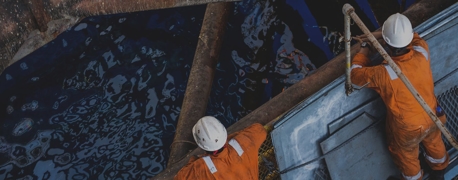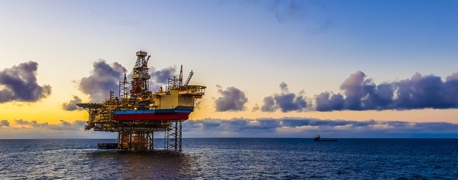Helicopters & Oil Rigs: The Dangerous Commute for Offshore Workers

As dangerous as it is to live and work on an offshore oil rig, the riskiest part of an offshore worker's career is transportation in helicopters to and from the rig. Oil rig workers in the U.S. are seven times likelier to die on the job compared to all other U.S. workers, per the CDC, and from 2003 to 2010, more than half of offshore workers' deaths were due to transportation incidents. Of those fatal transports, the vast majority (75% of such accidents) were helicopter crashes. While the work itself is still fraught with hazards, it's the trip to or from the work itself that often poses the deadliest challenge.
This is a risk that simply can't be avoided either, as helicopters are relied on for emergency evacuations, to fly in emergency aid and equipment, bring the rig food, and more. The only other option for offshore transportation is boats, and helicopters are generally deemed the safer and more reliable option. Even so, helicopter crashes offshore have always been a hazard in the industry, and as helicopter services are expected to only increase in demand through 2025, this is a risk that will remain.
Helicopter transportation can end in disaster due to everything from bird strikes and adverse weather conditions to non-activation of floatation devices and pilot error. Many of the causes of a helicopter crash overlap. In this article, we'll take a look at some of the crash risks that pilots and offshore workers face in helicopter transportation, and the slow pace of safety regulations and implementations that do little to mitigate these risks.
What Are Some of the Main Risks of Offshore Helicopter Flights?
Some of the main risks that lead to offshore helicopter accidents include:
- Weather conditions / poor visibility
- Extreme temperatures (which can lead to equipment failure)
- Oil rig gases (which can affect both pilots and equipment)
Based on CDC statistics (and they haven't updated them for quite a while), there are approximately eight fatalities a year due to helicopter transportation. This doesn't account for injuries sustained in helicopter accidents.
Helidecks may be no more than 24 by 24 feet, just enough space to land a helicopter above the ocean, where it's vulnerable to all sorts of weather conditions and only has a small area of safety, and slim margins for error.
Here is a sample of a few recent offshore helicopter accidents reported by the National Transportation Safety Board (NTSB):
- On October 26, 2022, the Coast Guard was called in for a search and rescue after communication was lost with a helicopter that was returning to land after it had transported telecommunications workers to various oil platforms. The helicopter was found wrecked in the water, with its two passengers managing to float as they grabbed onto the wreckage, though they were seriously injured, and the pilot had been killed. They said they had woken up to the pilot slumped in his chair, incapacitated but conscious enough to say, "he was not going to make it". The passenger upfront reached over and tried to slow the helicopter's rapid descent and managed to set off the skid-mounted float system.
- On Dec 15, 2022, a helicopter was letting passengers disembark on an oil platform's helideck when the wind pushed the helicopter to one side, and the skids were stuck, so the helicopter rolled over and off the platform. The pilot was able to engage the emergency floats in time, however, and everyone on the helicopter was able to get out and float in the water until they were rescued. The three occupants all sustained minor injuries.
- On December 29, 2022, there were no direct eyewitness or camera footage, and only preliminary investigations have been reported, but four people, a pilot and three platform workers, were killed in a helicopter accident while taking off from an oil platform in the Gulf of Mexico. People did report hearing the helicopter's engine, and then items striking against the platform. Upon going outside to investigate, they found the helicopter flipped over in the water, the tail and landing skids broken off. Personnel on the platform set out in an emergency escape capsule, but they couldn't get to the wreckage before the main section of the helicopter sank, with all four occupants trapped inside.
1. Strong Winds & Offshore Helicopter Accidents
On land, it's not common for a pilot to have to deal with wind speeds of 55 to 63 miles per hour, winds that are strong enough to uproot trees. However, wind speeds can reach such an intensity with more frequency offshore. Even when a storm is rolling in, before conditions are that of a full-blow hurricane, wind speeds can exceed 70 miles per hour and create 30 to 45-foot waves, yet another reason why timing any weather-imposed evacuations is crucial for everyone's safety. Even flotation devices aren't going to help if you fall into that water.
As dangerous as it is to fly over vast swaths of empty ocean, this danger doesn't let up even once a helicopter has safely landed on an oil platform's helideck. The helicopter is still thoroughly exposed and vulnerable to powerful, shifting wind patterns, and if adverse weather conditions move in while the helicopter is landed, it will be too late to safely fly away in those conditions. The crew can only tie down the rotor blades and ride the weather out inside the oil rig's living quarters. If it's too late to even tie down the rotor blades, winds can be powerful enough to snap the rotor blades themselves, becoming another dangerous projectile on the oil rig platform.
Evacuations when a storm or hurricane is rolling in, however, can cut the timing close, and lifting off the helideck doesn't automatically mean you're on your way to safety. There are dangers to ride out the whole way back.
2. Extreme Temperatures Contribute to Helicopter Crash Risks
Helidecks need to be in good condition for helicopters to land year round. When snow, ice, or frost set in, these sections of the oil rig platform need to have functioning de-icing systems. These are supposed to trigger automatically when temperatures reach certain lows, and with the right heating cables and drainage, helidecks should be free of frozen hazards. It takes adequate, regular maintenance to ensure the system works as it needs to—before the need arises.
In other seasons, when hot air flows in, especially if it's in stark contrast to the temperature beforehand, this heat can stall helicopter engine due to the shift in air density in the turbine compressors, and it can also inhibit how much the helicopter is able to safely lift.
These are just some of the monitors and maintenance on the helideck that are needed for a helicopter to safely land on an oil rig platform. Other helideck systems that a pilot relies on include some of the alarms and communications needed when it comes to flying near to dangerous oil rig processes and gases.
3. Hydrogen Sulfide & Vented Methane Gas Endanger Helicopters
Hydrogen sulfide is one of the gases that can be present at an oil rig, and in just the few seconds it takes a pilot to note a rotten egg smell, the gas can knock the pilot out. The Federal Aviation Administration (FAA) recommends that pilots be equipped with protective air packs to prevent losing consciousness, and that personnel on oil rigs should have a bright red light to fire up when hydrogen sulfide is noticed, alerting the pilot to put on that air pack and find a way to move upwind.
Offshore oil rigs also flare and vent combustible gases, burning off the gas they can't sell or use and venting that gas out into the atmosphere. Even before gas is burned off, methane gas can still be released from gas vents. This all happens fairly routinely, and it pollutes the environment, wastes resources, and poses serious risks for helicopter engines. Methane gas, or any mixtures of gases, that gets vented can be ingested by the helicopter's turbines, causing partial engine failure or a total flameout. This can happen as a helicopter approaches a helideck when the gas is close enough to be ingested by turbines. Or after a safe landing, the danger may not be apparent until takeoff, when a compressor suddenly stalls. This happens more often than it should because not only is venting not regulated, but the placement of gas vents is also not standardized, with some oil rigs having the vents closer to the helideck than they should be.
The Bureau of Safety & Environmental Enforcement (BSEE) realized that there are no regulations for where gas vents should be placed on an oil rig and went so far as to recommend that this be standardized so that these vents would be built at an adequate distance away from helidecks to reduce the risk of gas ingestion. The BSEE also noted that whenever there is active venting and a helideck is downwind of these vents, that a helideck should be presumed to be polluted with petroleum gases and should thus be marked as not safe for landing, or that pilots should wait for takeoff.
The BSEE also recommended that oil rigs implement sensors to gauge when combustible gases are being released that could affect a helicopter, and to perhaps include equipment that could diffuse the gases being released from vent stacks.
So far, these recent notations of the risks that helicopter pilots face appear to only have been followed up by recommendations, nothing as stringent as a rule or regulation, and lacking any enforcement options that could ensure that these gas risks are mitigated. There is no clear indication on whether these recommendations have been adopted widely either. With government agencies only doing so much, the responsibility for helicopter pilot and passenger safety in offshore transportation lies with the aviation and oil rig companies involved.
Keeping Offshore Helicopter Pilots & Passengers Safe
Companies owe it to their pilots to equip them with all the PPE they need, from protective air packs to fire-resistant gear and life jackets, as well as the training necessary to abruptly shift their flight plans in the face of fast-changing weather. Aviation companies are also responsible for ensuring that every instrument and piece of equipment on a helicopter is well-maintained and in good condition. Oil companies also have a responsibility to maintain the monitors and machinery on a platform. Oil companies must provide their employees with adequate training to ensure that processes like venting don't interfere with anyone's safety, providing the plans and technology to have their crews communicate in a timely, clear manner to approaching aircraft.
It is also up to these corporations involved to invest in reliable weather forecasting technology and communication systems to ensure that pilots have all the information they need to conduct a safe flight and to depart from oil rigs in a timely manner.
There are only so many factors that can be controlled when you're flying over the open ocean, but if employers are responsible with all the factors that they do control, this can reduce many of the tragic and tragically preventable helicopter accidents that jeopardize pilots, oil rig workers, and their loved ones.


